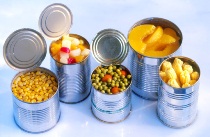
We are all aware of the need to consume 5 or more servings of fruit and vegetables a day. But what many people don't realise is that canned fruit and vegetables count towards that total and are included in the Ministry of Health's recommended fruit and vegetable forms along with fresh, frozen, juiced and dried forms.
Because canned food is so ubiquitous, people tend not to think about the process of canning fresh food or the fact that what is inside the can comes straight from nature. Canning is simply a clever process that allows us to conveniently store and package fruit and vegetables in steel cans which, not only provides year-round variety, but also ensures that nutrient content remains almost constant during storage.
The canning process is nothing new. Pioneered in the 1790s, canning is an age old preservation method that many home bottlers know well. With technological advancements the process today is far more sophisticated, but the principle remains the same: fresh produce is washed, peeled and sliced or diced as required, then placed in cans along with the appropriate liquid. The cans are sealed and then cooked at a high temperature to preserve the food and once cooled and washed, labels are applied. While the heat treatment will cause some initial reduction in nutrient content, once completed, the nutrient content remains relatively stable. The heat treatment sterilises the contents, so the need for preservatives is eliminated.
You might also like: Vegetables in a Toddlers Diet









Join the Discussion
Type out your comment here:
You must be logged in to post a comment.